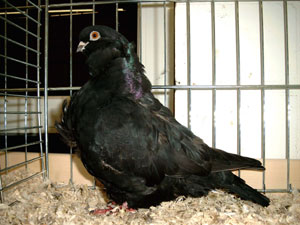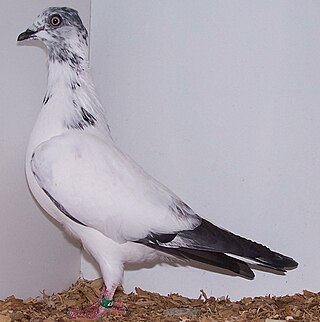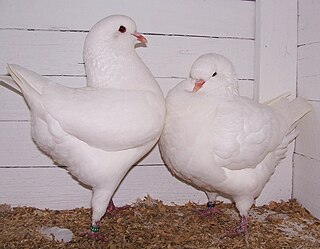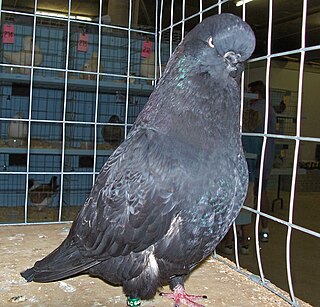Fancy pigeon refers to any breed of domestic pigeon, which is a domesticated form of the wild rock dove. They are bred by pigeon fanciers for various traits relating to size, shape, color, and behavior, and often exhibited at pigeon shows, fairs and other livestock exhibits.

The Fantail is a popular breed of fancy pigeon. It is characterised by a fan-shaped tail composed of 30 to 40 feathers, abnormally more than most members of the dove and pigeon family, which usually have 12 to 14 tail feathers. The breed is thought to have originated in Pakistan, India, China, Japan or Spain. There are several subvarieties, such as the English Fantail, the Indian Fantail, and the Thai Fantail. Charles Darwin used it as one of the examples in the first chapter of his book On the Origin of Species. He believed it was a descendant of the rock dove.

The Bokhara Trumpeter is a breed of fancy pigeon developed over many years of selective breeding. Bokhara Trumpeters, along with other varieties of domesticated pigeons, are all descendants from the rock pigeon . The breed is known for its long muffed (feathered) feet and double crest.

The African Owl is a breed of fancy pigeon developed over many years of selective breeding. They originated in Tunisia (Africa), and were imported into England during the 19th century. The breed is known for its short beak, which gives the breed the "Owl" name due to the size and shape.

The English Short-faced Tumbler is a breed of fancy pigeon developed over many years of selective breeding. English Short-faced Tumblers along with other varieties of domesticated pigeons are all descendants of the rock dove. The English Short-faced Tumbler is one of the oldest breeds referred to in John Moore's book Columbarium: or, The pigeon-house; being an introduction to a natural history of tame pigeons, giving an account of the several species known in England, with the method of breeding them, their distempers and cures.

The Danzig Highflyer is a breed of fancy pigeon developed over many years of selective breeding. Danzig Highflyers, along with other varieties of domesticated pigeons, are all descendants from the rock pigeon. There are two major variates of the Danzig Highflyer: ones that are bred for show, and others as pets for flying.

The Chinese Owl is a breed of fancy pigeon developed over many years of selective breeding. Chinese Owls, along with other varieties of domesticated pigeons, are all descendants from the rock pigeon. The breed is known for its small size and profuse frilled feathers. Many specimens of this breed have a 'chin-crest' around the frontal region of its neck - it does not extend around to the back of the head. The feathers are more 'ruffled'and appear 'wind-swept' rather that 'curled' as in the frill varieties. The breed comes in many colors : black, brown, blue/ blue-grey, barred, ice, satinette blondinette, white, pied and white-black (combinations).

The Dönek is a Turkish breed of fancy pigeon developed over many years of selective breeding. The name Donek is of Turkish language origin and means, "turning and dropping down from the sky. These breeds are found around THE WORLD and in previous ottoman states like Greece and Macedonia" The Alina, along with other varieties of domesticated pigeons, are all descendants from the rock pigeon . The breed is known for its aerial acrobatics and as such is more of a performance breed rather than a purely fancy variety. Their aerial spiraling return when called back to the loft makes a spectacular sight.

The Oriental Frill is a breed of fancy pigeon developed over many years of selective breeding. It is originally a Turkish pigeon breed specially bred for the Ottoman Sultans in the Manisa Palace, Turkey. Manisa is an old Ottoman city in western Turkey. It is called Hünkari: the bird of the Sultans in its homeland. The variety is divided into several variations in color and markings with Blondinettes and Satinettes being the most common.

Flying/Sporting is the name of one of three main groupings of breeds of domesticated pigeons used by pigeon fanciers in the United States. The other two are Fancy and Utility.

Utility pigeons are domesticated pigeons bred to be a source of meat called squab. Squabs have been used as a food in many nations for centuries. They were bred to breed and grow quickly. Because they are bred for squab production, conformation to a show standard is usually deemed unimportant.

The Ice pigeon is a breed of fancy pigeon developed over many years of selective breeding. Ice pigeons, along with other varieties of domesticated pigeons, are all descendants from the rock pigeon.

The King pigeon is a breed of pigeon developed over many years of selective breeding primarily as a utility breed. Kings along with other varieties of domesticated pigeons are all descendants from the rock dove.

The English Long-faced Tumbler is a breed of fancy pigeon developed over many years of selective breeding. English Long-faced Tumblers, along with other varieties of domesticated pigeons, are all descendants of the rock dove.

The Dragoon is a breed of fancy pigeon developed over many years of selective breeding. Dragoons, along with other varieties of domesticated pigeons, are all descendants of the wild rock dove. The Dragoon was one of the breeds used in the development of the Racing Homer. A very old breed of British origin, referred to by Moore (1735).

The English Trumpeter is a breed of fancy pigeon developed over many years of selective breeding. English Trumpeters, along with other varieties of domesticated pigeons, are all descendants from the rock pigeon. This is one of the most popular breeds in the USA. The English Trumpeter is regarded as one of the most ornamental breeds of fancy pigeon. The most distinguishing feature of this breed are the very large muffs on its feet, which often grow to sizes close to its flight-feathers. Combining a tuft, crest and large muffs on their feet, they are challenging to breed. They are bred in a number of colours which are listed under self, splash and baldhead.

The Barb is a breed of fancy pigeon developed over many years of selective breeding. Barbs, along with other varieties of domesticated pigeons, are all descendants from the rock pigeon . This breed was referred to by Shakespeare. It was also referred to with an illustration in Charles Darwin's Variation of Animals and Plants under Domestication. It has been marked as cruel by many organisations due to the size of its beak which means it has trouble feeding its young and surviving.

The Budapest Highflyer is a breed of fancy pigeon developed over many years of selective breeding. Budapest Highflyers, along with other varieties of domesticated pigeons, are all descendants from the rock pigeon . The breed is the most popular in its native Hungary.

The Reverse-wing Pouter is a breed of fancy pigeon developed over many years of selective breeding. Reverse-wing Pouters, along with other varieties of domesticated pigeons, are all descendants from the rock pigeon . The breed is known for its eye-catching markings.


















